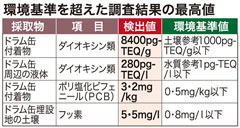Levels of Agent Orange ingredients found in Okinawa City exceed Environmental Quality Standard

Investigation results revealed the highest values of dioxins exceeded the Environmental Quality Standard.
August 1, 2013 Ryukyu Shimpo
The Okinawa Defense Bureau detected dioxin and other harmful ingredients inside the barrels found at a soccer ground on land returned by the U.S. military in Okinawa City. The levels found exceeded the Environmental Quality Standard set by the Japanese government.
The Okinawa City Government released the results of their investigation on July 31.
They detected dioxin in fouling material at a level 8.4 times the normal standard for soil, and in the water it was 280 times the standard for groundwater. They found the key ingredient of Agent Orange in the barrels. The city government asked Nansei Environment Laboratory Co. to carry out the investigation.
The company said the barrels possibly contained Agent Orange because they bear the logo of the Dow Chemical Company, the United States based chemical manufacturer that produced Agent Orange during the Vietnam War.
The city government explained the results to the central and prefectural governments and city assembly on July 31.
That afternoon, the assembly held a meeting of its special committee investigating U.S. military base issues. The committee unanimously adopted a statement in which they asked the Japanese government to carry out a full-scale investigation and restore land returned by the U.S. military to its proper state. A special session of the assembly adopted the statement on August 5. The bureau found the key ingredient of Agent Orange–2, 4, 5-T, trichlorophenoxyacetic acid, in 18 of the 22 analytes from the barrels. They did not detect the other key ingredient of the defoliant–2, 4-dichlorophenoxyacetic. The bureau detected polychlorinated biphenyls in 11 of the 22 analytes. The highest value was 3.2 milligrams per kilogram at a level 6.4 times the standard.
The Nansei Environment Laboratory Co.’s report indicated that the composition of the dioxins in the barrels is related to Pentachlorophenol found in pesticides and herbicides. Levels of arsenic and fluorine found were slightly higher than the standard. The company suggested that harmful substances, including Agent Orange caused the pollution of the soil and groundwater at the site.
Of the 22 analytes from the barrels, two exceeded the normal standard for soil. The highest value was 8,400 picograms TEQ per gram. The level of dioxin in the water around the soil was 280 picograms TEQ per liter. The bureau found a large quantity of 2, 3, 7, 8-tetrachlorodibenzo, an ingredient unique to the defoliant. It is possible that the barrels contained dioxin related to Agent Orange because the ingredient accounted for 70 percent of the chemical.
Levels of dioxins found in the surface layer of the ground, surplus soil and the soil of land returned by the U.S. military in what was Camp Lester were substantially lower than the standard.
The bureau found 340 picograms of dioxin TEQ per gram, which is lower than the standard in the soil. However, it is higher than the level that requires caution: 250 picograms TEQ per gram.
Previous Article:Film Director Oliver Stone urges Okinawans to wage nonviolent struggle
Next Article:Battle of Okinawa PTSD symposium held at Hitotsubashi University
[Similar Articles]
- Okinawa detects Agent Orange ingredients in barrels found on land returned by U.S. military
- Dioxins detected in all analyses of barrels found in Okinawa City
- Toxic dioxin found inside barrels unearthed at a soccer ground on land returned by the U.S. military in Okinawa City
- [Editorial] US and Japan need to investigate Agent Orange in Okinawa
- U.S. military storage of Agent Orange in Okinawa
 Webcam(Kokusai Street)
Webcam(Kokusai Street)


